Nippur – Holy City Of God Enlil And One Of The Oldest Cities Of Sumer
A. Sutherland - AncientPages.com - Nippur (Sumerian: Nibru, "Enlil City"; Akkadian: Nibbur) was among the most ancient Sumerian cities and one of the most important religious centers throughout Mesopotamia. Some researchers date back the city's creation to about 5000 BC.
In the 4th millennium BC the temple of the Sumerian wind god Enlil at Nippur in present Iraq was a famous pilgrimage center. The rectangular palace atop the ancient ziggurat dates from the Parthian period and is thus thousands of years younger. Omage credit: David Stanley - CC BY 2.0
Throughout the history of Sumer, Nippur - located northeast of the town of Ad-Diwaniyah, now in southeastern Iraq - had a special place among the cities.
Based on the earliest existing records, it is known that Nippur was not a capital but a sacred city, a central and unique shrine of the region. Its holy character helped Nippur survive several wars and the fall of dynasties that destroyed other cities.
Nippur was the seat of Enlil, the chief god of the Sumerian pantheon, the "Lord Wind," ruler of the cosmos, and one of the triads of gods, including Anu (Sumerian: An) and Ea (Sumerian: Enki). The city - located halfway between Ur and Sippar - also played a significant political role.
Based on the earliest existing records, it is known that Nippur was not a capital but a sacred city, a central and unique shrine of the region. Its holy character helped Nippur survive several wars and the fall of dynasties that destroyed other cities.
Nippur, Temple of Bel excavation, 1896. Hilprecht, H. V. (Hermann Vollrat), 1859-1925 - Old Babylonian inscriptions. Published 1896 - Public Domain
Kings were involved in the city's restoration of temples, construction of fortification walls, public administrative buildings, and canals. Even after 1800 BC., when the Babylonians made Marduk the most critical god in southern Mesopotamia, Enlil was still worshiped and had his sanctuary. Nippur remained a holy and prestigious city, with over a hundred temples, regardless of which dynasty ruled Mesopotamia.
Probably because of its strategic location and sacred meaning, it remained a neutral city.
Cuneiform tablet from Nippur, in the name of Shar-Kali-Sharri, 2300–2100 BC. Image credit: Mary Harrsch - CC BY 2.0
Nippur's most significant growth occurred under the Ur III kings (c. 2100 BC). It was almost matched in the time of the Kassites (c. 1250 BC.) and when the Assyrians from northern Iraq dominated Babylonia (c. 750-612 BC).
The first mention of Nippur is related to the construction of a temple dedicated to Enlil. It was erected during the reign of King Enmebaragesi, a king of Kish, according to the Sumerian king list. The list states that he subdued Elam and reigned for 900 years.
Enmebaragesi dominated Sumer around the year 2700 BC and also controlled Nippur. Little is known about the prehistoric city of Nippur, but by 2500 BC, the city expanded, was fortified, and probably reached the extent of the present remains.
In about 2450 BC, the city became part of the empire of Eannatuma of Lagash. About 2430 BC, Nippur was conquered by Enshakushanna, a king of Uruk in the later 3rd millennium BC, who, according to the Sumerian King List, reigned for 60 years.
Babylonian cuneiform tablet with a map from Nippur, Kassite period, 1550–1450 BC. Image credit: Mary Harrsch - flickr.com - CC BY 2.0
About .2300 BC, Sargon's Akkadian empire controlled the city, and around the year 2230 BC, Sargon's grandson - Naram-Sin - under the influence of the temple's oracle, attacked Enlil in Nippur. As a result, there was a meeting of the eight most essential gods, who withdrew their support for the king; the city's inhabitants began to suffer from hunger.
With the collapse of the Sumerian civilization and Ur about 2000 BC, Nippur was briefly occupied by the Elamites and later incorporated into the Amorite kingdom of Isin.
The remains of the Nippur, which today are named Nuffar, were excavated in 1851 and during different periods, namely in 1888 - 1900 and 1948 – 1990.
In the city's eastern part, the so-called 'scribal quarter,' archaeologists unearthed several thousands of Sumerian tablets, with economic, linguistic, and many examples of the Sumerian literary texts. Most of them were found in the archives in two private homes.
Another part of the city was the 'sacred area' with the temple complex and a ziggurat called E-kur (in its present form), where construction works were performed by the first kings of the Third Dynasty of Ur - Ur-Nammu and Shulgi (2094–2047).
In one of the trenches, archaeologists discovered two prominent temples; one was the temple of Inanna, goddess of love and war, one of the most important deities in the Mesopotamian pantheon, and another, the Temple of the North – the remains of the palace, the temple library, which provided 20 thousand tablets and tombs, where the dead were buried after partial burning.
The excavation conducted in 1990 revealed an Akkadian tomb and a large temple to Bau (Gula), the Mesopotamian goddess of healing and medicine, whose special symbol was a dog.
Among various artifacts were several figurines of dogs found on floors and buried in the plaster on walls; fragmentary figures of human beings having pain; one with his hand to his throat, another with one hand to his head, and one to his stomach.
Written by A. Sutherland - AncientPages.com Staff Writer
Updated on January 16, 2024
Copyright © AncientPages.com All rights reserved. This material may not be published, broadcast, rewritten or redistributed in whole or part without the express written permission of AncientPages.com
Expand for referencesKramer Samuel Noah. N. The Sumerians
Kriwaczek, Paul. Babylon: Mesopotamia and the Birth of Civilization
More From Ancient Pages
-
 Ancient History Of Chinese Swords
Featured Stories | Aug 20, 2018
Ancient History Of Chinese Swords
Featured Stories | Aug 20, 2018 -
 Incredibly Well-Preserved Viking Age Ski Discovered Under Melting Ice
Archaeology | Nov 8, 2022
Incredibly Well-Preserved Viking Age Ski Discovered Under Melting Ice
Archaeology | Nov 8, 2022 -
 Mysterious Hieroglyphs Point To The Location Of Queen Nefertiti’s Tomb?
Archaeology | Sep 29, 2022
Mysterious Hieroglyphs Point To The Location Of Queen Nefertiti’s Tomb?
Archaeology | Sep 29, 2022 -
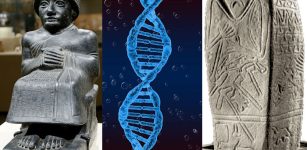 Ancient DNA Provides Comprehensive Genomic History Of The “Cradle Of Civilization”
Archaeology | Oct 10, 2022
Ancient DNA Provides Comprehensive Genomic History Of The “Cradle Of Civilization”
Archaeology | Oct 10, 2022 -
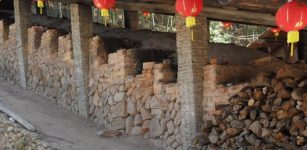 Ceramics Are Telling The Story Of 14th Century Chinese Trade
News | Jun 28, 2023
Ceramics Are Telling The Story Of 14th Century Chinese Trade
News | Jun 28, 2023 -
 Massive Menhir Champ Dolent Built By Fairies In Ancient Beliefs Of Brittany’s People
Featured Stories | Jan 13, 2025
Massive Menhir Champ Dolent Built By Fairies In Ancient Beliefs Of Brittany’s People
Featured Stories | Jan 13, 2025 -
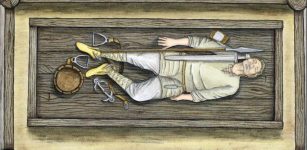 Magnificent Chamber Graves Of Four Scandinavian Warriors Discovered In Poland – The Piast Dynasty In New Light
Archaeology | Jan 22, 2020
Magnificent Chamber Graves Of Four Scandinavian Warriors Discovered In Poland – The Piast Dynasty In New Light
Archaeology | Jan 22, 2020 -
 Little Known Neanderthal Technology Examined – Turning Bones Into Tools
Archaeology | Jun 19, 2023
Little Known Neanderthal Technology Examined – Turning Bones Into Tools
Archaeology | Jun 19, 2023 -
 100,000-Year-Old Case Of Deafness Discovered In Fossilized Skull Of Hunter-Gatherer
Archaeology | Jul 21, 2022
100,000-Year-Old Case Of Deafness Discovered In Fossilized Skull Of Hunter-Gatherer
Archaeology | Jul 21, 2022 -
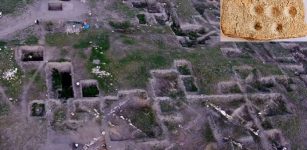 5,000-Year-Old Stone Paint Palette Unearthed In Küllüoba Mound
Archaeology | Sep 9, 2020
5,000-Year-Old Stone Paint Palette Unearthed In Küllüoba Mound
Archaeology | Sep 9, 2020 -
 Rock-Cut Tomb Of Pennut, Viceroy Of Nubia Under Reign Of Ramses VI
Civilizations | Dec 7, 2018
Rock-Cut Tomb Of Pennut, Viceroy Of Nubia Under Reign Of Ramses VI
Civilizations | Dec 7, 2018 -
 Was 4,000-Year-Old Seahenge In Norfolk Built To Battle Climate Change?
Archaeology | May 31, 2024
Was 4,000-Year-Old Seahenge In Norfolk Built To Battle Climate Change?
Archaeology | May 31, 2024 -
 On This Day In History: Albertus Magnus – Medieval Person Of Great Historical Importance Died – On Nov 15, 1280
News | Nov 15, 2016
On This Day In History: Albertus Magnus – Medieval Person Of Great Historical Importance Died – On Nov 15, 1280
News | Nov 15, 2016 -
 On This Day In History: Pueblo Indians Capture Santa Fe From The Spanish – On August 21, 1680
News | Aug 21, 2016
On This Day In History: Pueblo Indians Capture Santa Fe From The Spanish – On August 21, 1680
News | Aug 21, 2016 -
 Artifacts From King Henry VIII’s Warship The Mary Rose – Analyzed
Archaeology | Apr 28, 2020
Artifacts From King Henry VIII’s Warship The Mary Rose – Analyzed
Archaeology | Apr 28, 2020 -
 Rare Bronze Age Sacrificial Offerings, Including A Bent Sword Found In A Bog Near Veksø, Denmark
Archaeology | Dec 3, 2024
Rare Bronze Age Sacrificial Offerings, Including A Bent Sword Found In A Bog Near Veksø, Denmark
Archaeology | Dec 3, 2024 -
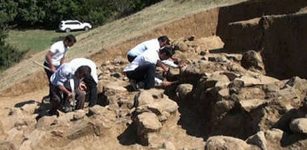 New Findings In Ancient Palidli Necropolis, Agdam Azerbaijan
Civilizations | Sep 24, 2015
New Findings In Ancient Palidli Necropolis, Agdam Azerbaijan
Civilizations | Sep 24, 2015 -
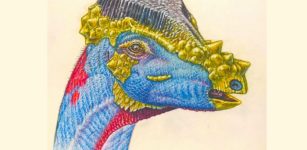 Newly Described Species Of Dome-Headed Dinosaur May Have Sported Bristly Headgear
News | May 24, 2023
Newly Described Species Of Dome-Headed Dinosaur May Have Sported Bristly Headgear
News | May 24, 2023 -
 Caribbean Silk Cotton Tree And Its Dangerous Spirits In Myths And Legends
Featured Stories | Jan 29, 2024
Caribbean Silk Cotton Tree And Its Dangerous Spirits In Myths And Legends
Featured Stories | Jan 29, 2024 -
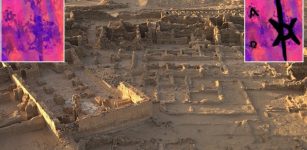 Rare Medieval Tattoo Depicting A Christogram Unearthed In Ghazali, Sudan
Archaeology | Nov 9, 2023
Rare Medieval Tattoo Depicting A Christogram Unearthed In Ghazali, Sudan
Archaeology | Nov 9, 2023




